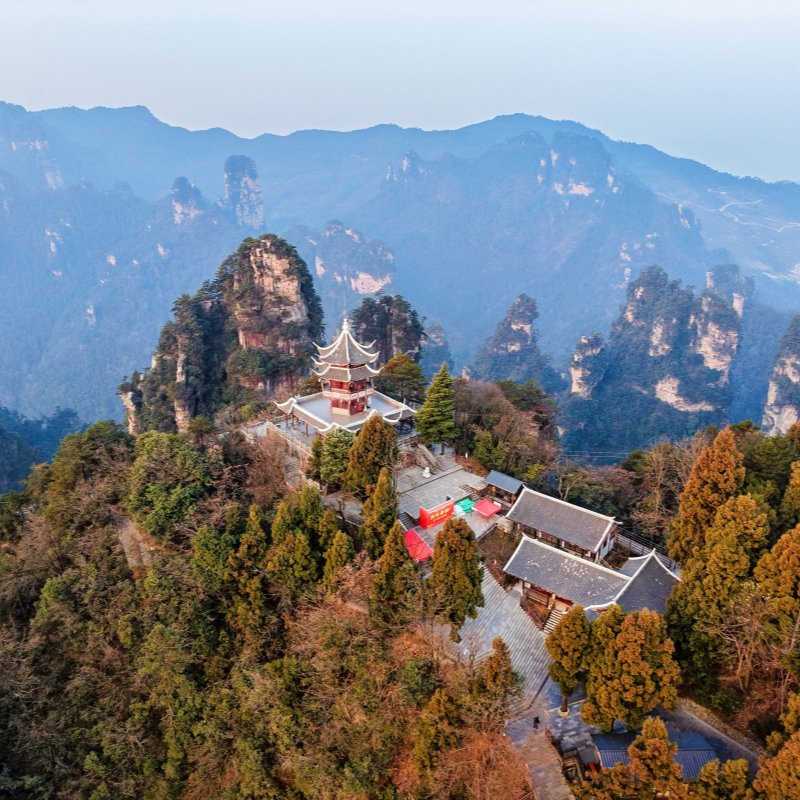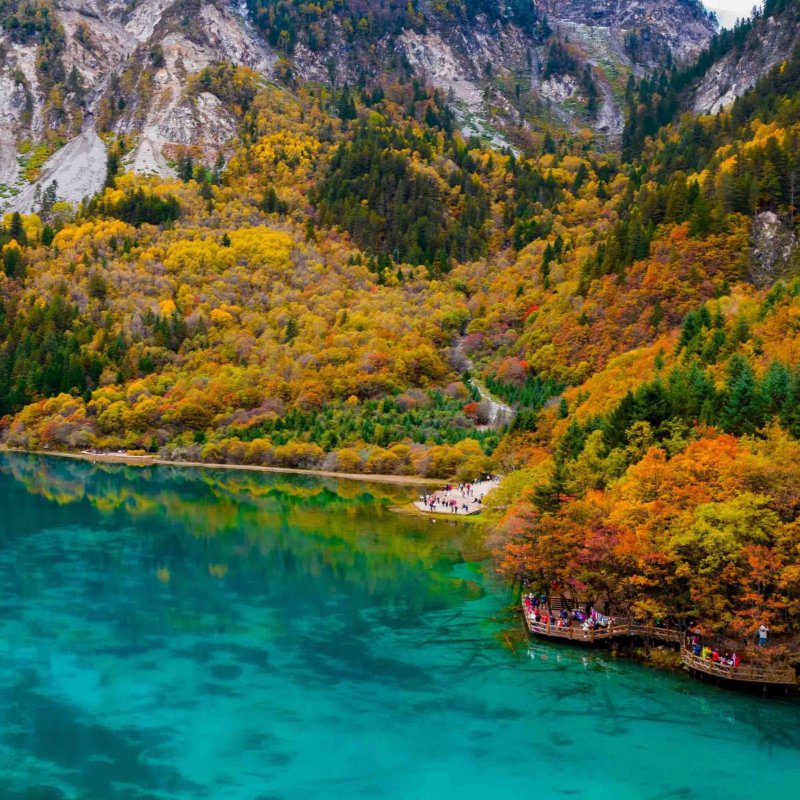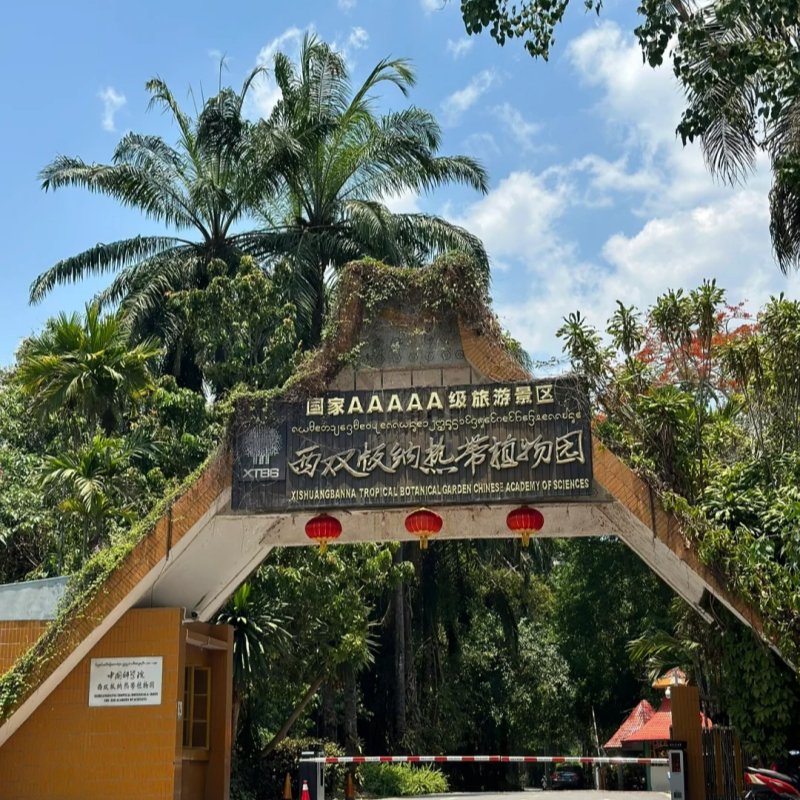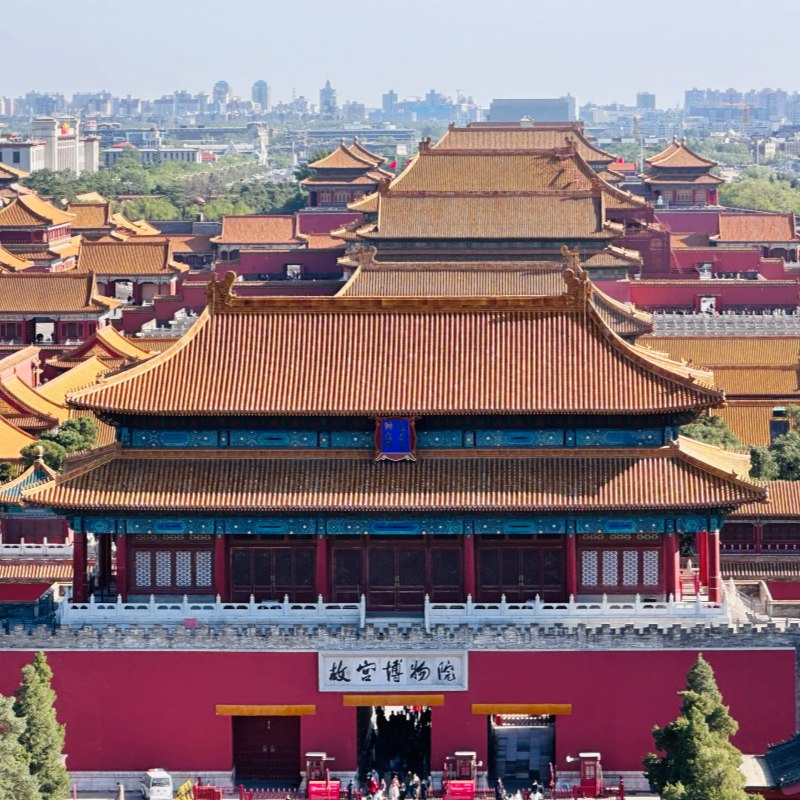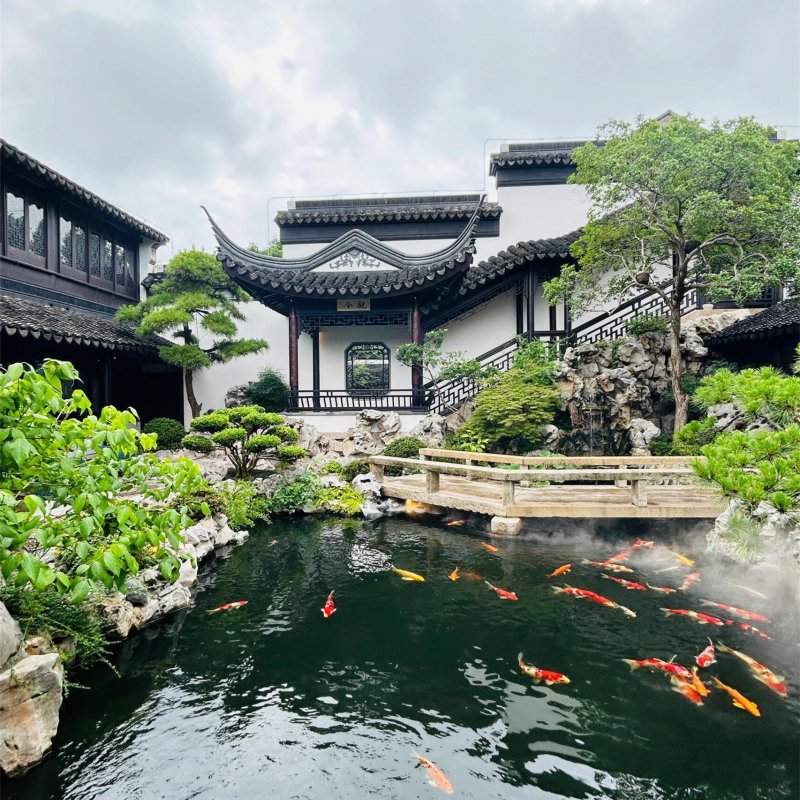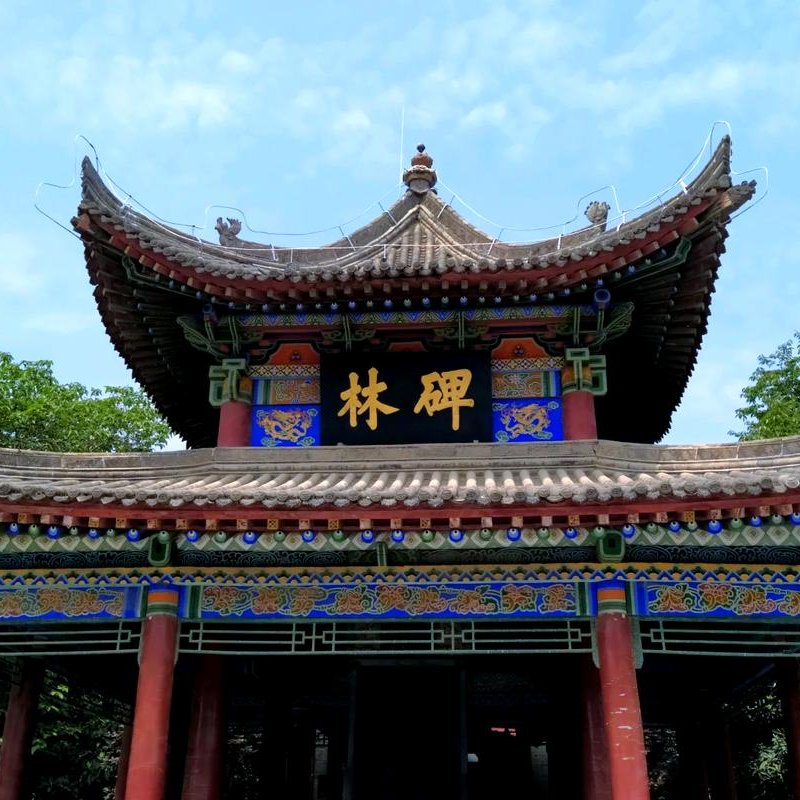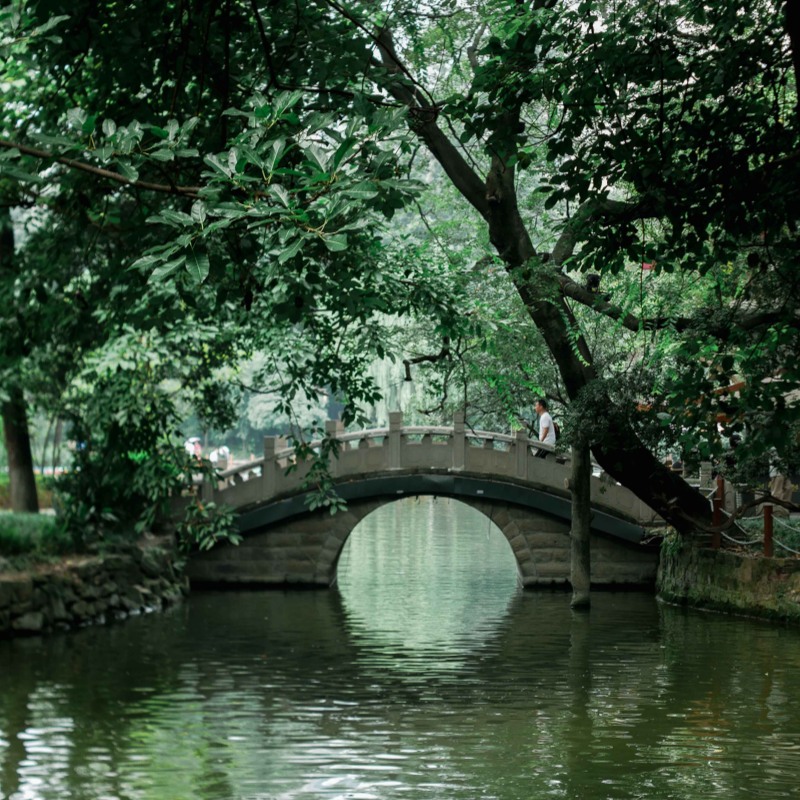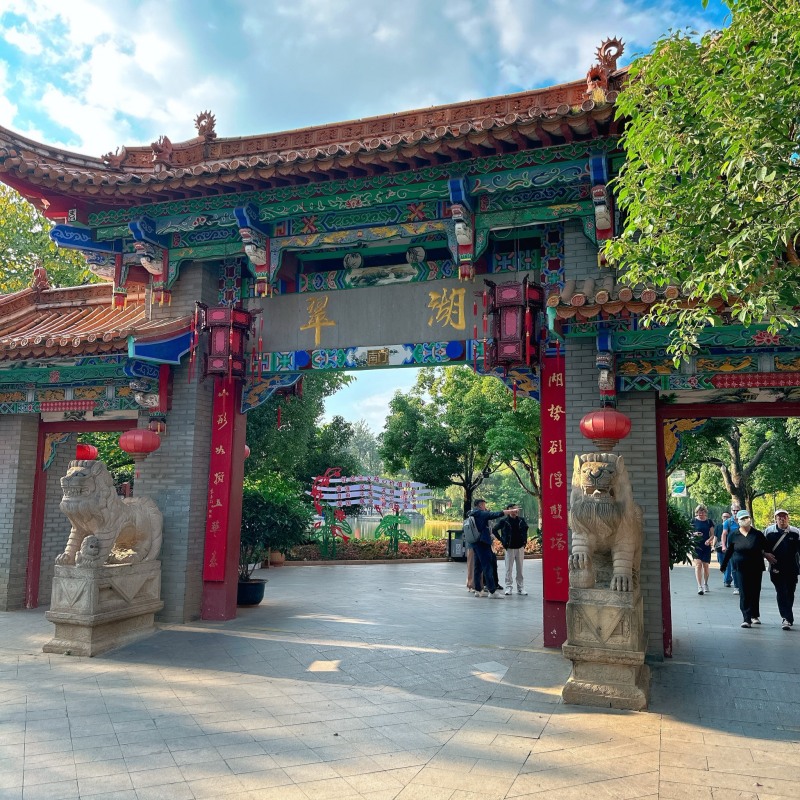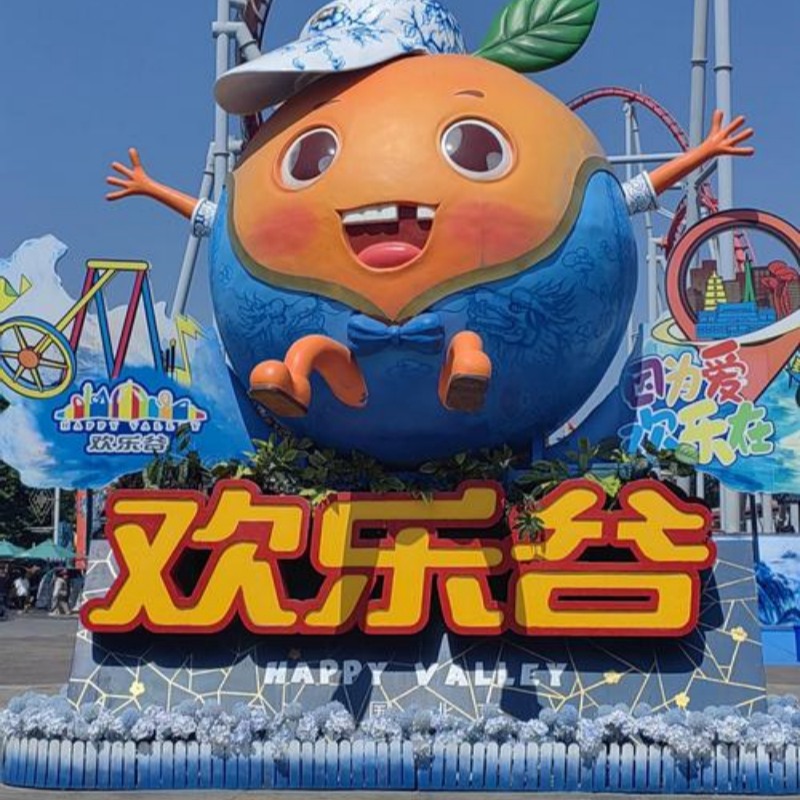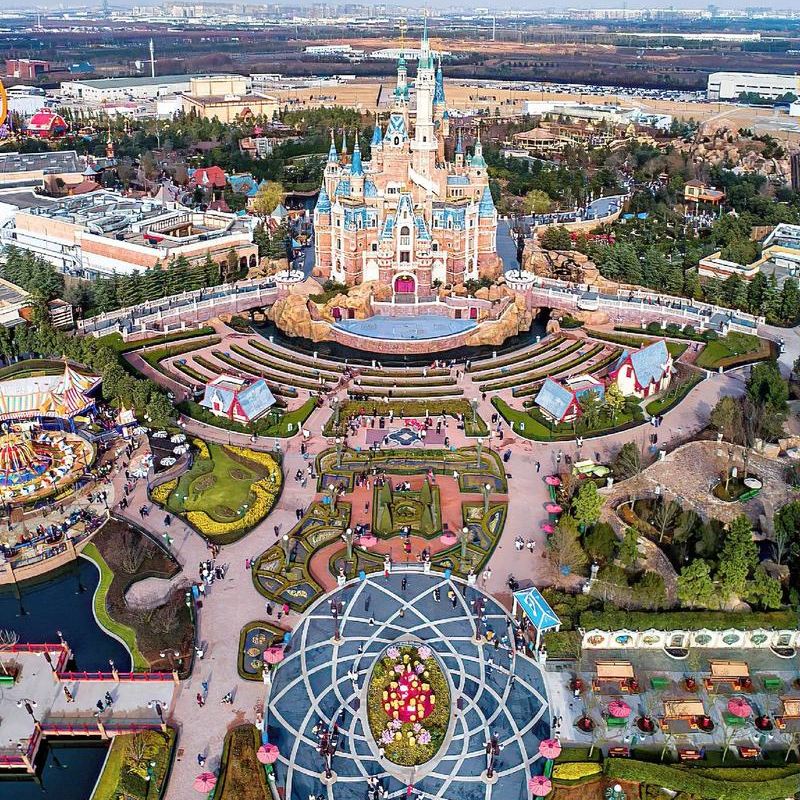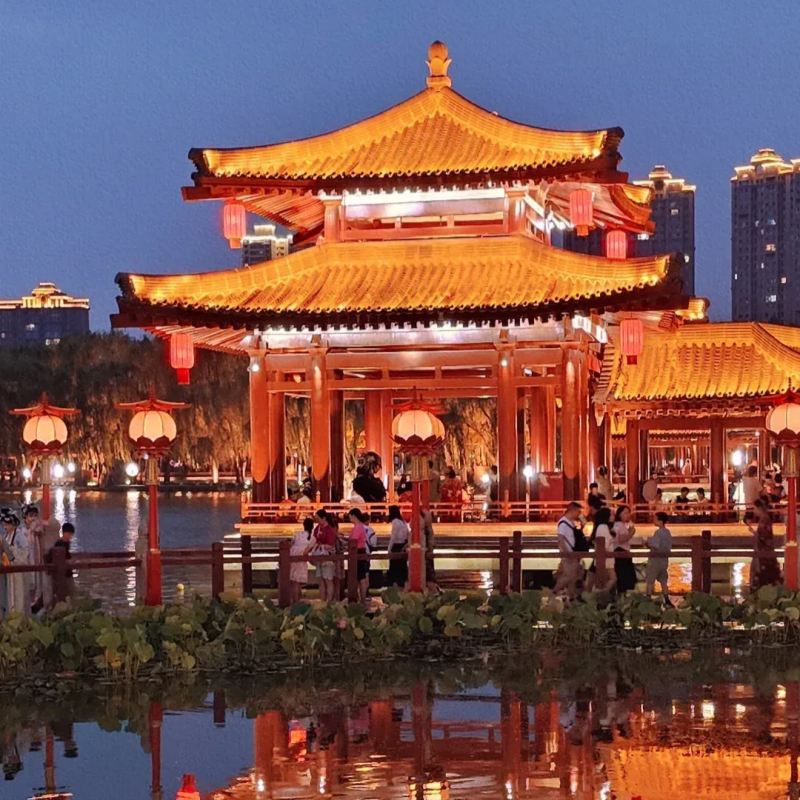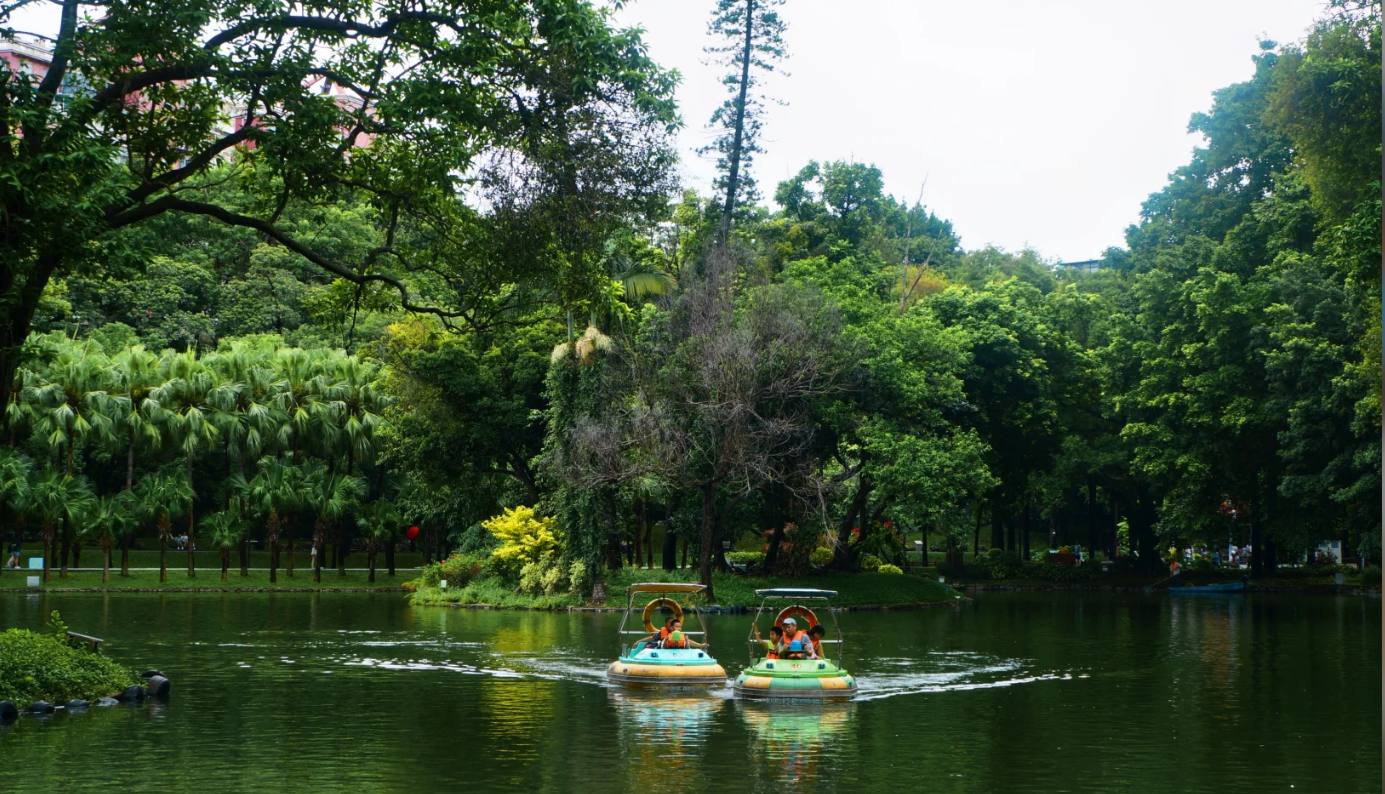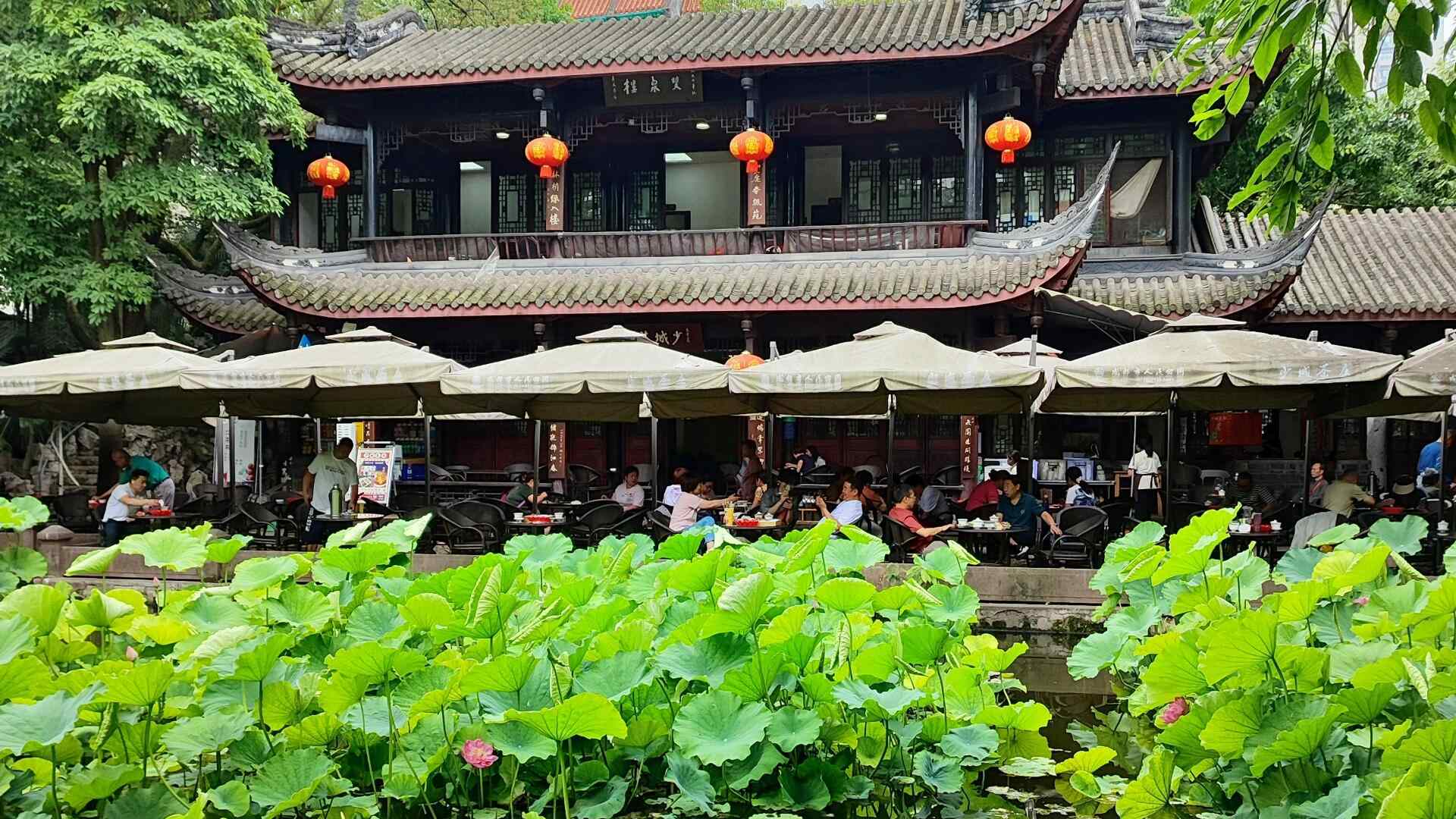Close your eyes and imagine a world filled with sound and color. You listen to the roar of a waterfall, spray hanging in cold air. Next is the steady clack of mahjong tiles in a gregarious teahouse. Breathe: your own warm breath; the musk of fresh earth after rain, mingled with jasmine from a sheltered pavilion. These are not fantasies but simply an average feature in Chinese society. This heartbeat throbs most powerfully in China’s parks, where nature and culture intertwine. In Zhangjiajie, for example, mist clings to stone pillars that resemble floating mountains in “Avatar,” and in Xi’an ancient courtyards resonate with history. Each park has its particular feel, a mixture of nature, memory and community. They combined to make tableaux vivants that transcend time. This guide leads you inside, down their paths and into the sights and sounds that reveal the real soul of parks in China.
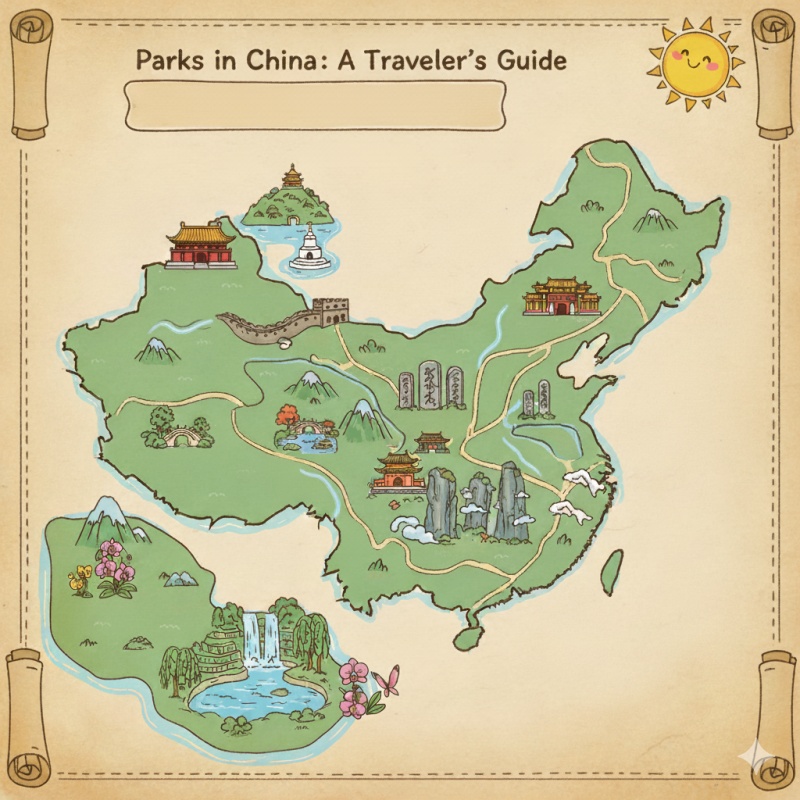
Park Map
Experience Natural Scenic Parks
- Zhangjiajie National Forest Park
- Jiuzhaigou National Park
- Xishuangbanna Tropical Botanical Garden
Zhangjiajie National Forest Park
The sandstone pillars of Zhangjiajie soar like colossal sculptures carved by nature over millions of years. Walking the trails, you catch a whiff of moist moss after rain and hear the shrill shriek of birds ricocheting off cliffs. Mist hangs between the peaks and floats them, so they become floating mountains. No wonder they were the inspiration for Avatar’s Hallelujah Mountains. Come dawn, the only sound you hear is birdsong, or an occasional monkey climbing from branch to branch that surprises hikers. Many are here for the film history, but the real alchemy happens during those first morning hours when the valleys seem untouchable and almost holy.
The park features trails for all fitness levels. Level walkways like Golden Whip Stream are mild and shrouded, an ideal choice for light walkers. Again, the steeper climbs (like Yuanjiajie) will bring you to the platform overlooking the Avatar Hallelujah Mountain, and Tianzi Mountain offers panoramic vistas of stone spires that retreat into mist for fitter hikers. Cable cars and eco-buses link key points, sparing time and energy. I rode the Bailong Elevator once — it zoomed me up, but I saw wildflowers and how fog clung to cliffs only when hiking back.
Weather here changes fast. In the wake of summer storms, clouds roll through the valleys, cloaking peaks in mystery. In July and August, pack water and light clothes; in the fall you’ll need layers for when a chilly breeze hits. Winter mornings might be icy, but frost on the twisted pines glimmers in sunlight and ethnicity seems to give the cliffs a refreshed beauty. Rain or shine, Zhangjiajie never fails to amaze and some even consider it one of the best natural parks throughout China.
Planning Zhangjiajie but worried about bad timing? Discover Best Time to Visit Zhangjiajie: Weather, Crowds, and What to Avoid
Practical Info:
📍 Address: Wulingyuan District, Zhangjiajie, Hunan
💰 Entrance Fee: 225 RMB (valid 4 days)
⏰ Hours: 7:00–18:00
🚇 Transport: Fly/train to Zhangjiajie City → Bus to Wulingyuan (40 min)
Jiuzhaigou National Park
Jiuzhaigou is a dream painted in water, and nowhere more so than at the renowned Five Flower Lake. The colors change from turquoise to emerald depending on the light and fallen tree trunks are visible — despite being underwater. Elsewhere waterfalls cascade from cliffs, the roar of water a constant presence in the air. I was standing beside a pond in October, its mirrored surface being ruffled by red and golden leaves that the wind blew across it, and I felt as if I’d come inside a painting that had come alive.
The park is large, but visitor-friendly due to its shuttle buses, which hop between the main sites. Buses are often packed in high season, but they spare exposure to the heat and hassle. Wooden boardwalks hug the lakes and deliver you close to the spray of waterfalls, while side trails provide less-traveled getaways for those who value solitude. Still, the trails are gentle and accessible even for nonhikers. I wandered for a few minutes by a narrow path off the trail and suddenly found myself alone with nothing but the sound of water rushing.
Each season changes Jiuzhaigou’s face. In spring, fresh flowers burst onto twin edges; fall immolates in fiery color on its flanks; while in winter, lakes freeze into crystal mirrors. In spring and summer, rains supply the waterfalls until they roar. It’s running water all the time, they’ll tell you wherever you are in Jiuzhaigou, because the park is alive. For so many, not only is it one of China’s most famous natural parks by far too but a place that leaves an indelible print in memory long after visiting(s).
Practical Info:
📍 Address: Jiuzhaigou County, Aba Tibetan-Qiang Prefecture, Sichuan
💰 Entrance Fee: 169 RMB (off-season), 280 RMB (peak)
⏰ Hours: 7:00–17:00
🚇 Transport: Flights to Jiuzhai Huanglong Airport → 1.5–2 hr bus
Xishuangbanna Tropical Botanical Garden
Located on either side of the Luosuo River in Southern Yunnan, Xishuangbanna Tropical Botanical Garden is a biodiversity heaven. Instead of the highest mountains in the world, you are among some of its tallest rainforest trees, as well as orchids and rare medicinal plants. The air is moist and dense with the sound of birds, while butterflies splotch bright color against shadowy paths. To walk here must be like walking inside a live encyclopedia of tropical life. The park for nature lovers who don’t like climbing hard hikes, Painted Canyon features soft paths where science meets beauty.
Garden zones The garden has themed zones. Families generally begin at the “Ethnic Plant Garden,” with straightforward signage explaining traditional Dai medicine plants. At the Rainforest Zone, stroll along suspension bridges beneath the majestic green canopies, and you can also tour the Palm Garden which presents plants from numerous corners of the globe. Visitors can also hop on small electric shuttles in they prefer saving energy, but to wander slowly is to find details — an orchid hidden at the base of a tree, a monkey darting across branches or the scent of earth after tropical rain falls. Traveling here is easy; there are guesthouses and eco-lodges open to foreign travelers who want to stay overnight in the nearby town of Menglun.
The weather here is a warm and humid throughout the year. There will also be times of rain showers, as sudden summer rains are fairly common as well. Winter is not harsh and it is one of the best time to visit comparing with colder area in China. The park is always full of tropical flower scents throughout the year, which makes a great heart beat. Many visitors depart saying that Xishuangbanna feels less like a garden and more like the gateway to China’s wild, tropical heart.
Practical Info:
📍 Address: Menglun Town, Mengla County, Xishuangbanna, Yunnan
💰 Entrance Fee: 80 RMB
⏰ Hours: 8:00–18:00
🚇 Transport: Fly to Xishuangbanna Gasa Airport → Bus/taxi to Menglun (1.5 hr)
Explore Historical and Cultural Parks
- The Forbidden City
- The Humble Administrator’s Garden
- The Forest of Stone Steles
The Forbidden City, Beijing
The Forbidden City is China’s most iconic palace complex and a UNESCO World Heritage site. To walk beneath the towering red walls is to step into another dynasty. Roofs covered in golden plates glint in the sun. I stopped inside the Hall of Supreme Harmony, imagining the emperor on his throne. The courtiers stood in rigid lines. The incense was suffocating in the air, and we could hear silken skirts rustling. For a minute, the past wasn’t so far away. It all felt very staged in front of me.
Touring like a Local A typical visit starts at the Meridian Gate. The way goes through the grand halls on the central axis. Visitors walk through the Hall of Supreme Harmony, Hall of Central Harmony and Hallof Preserving Harmony. The route concludes at the shaded Imperial Garden. It’s worth it to rent an audio guide or take a guided tour. Without assistance, one can easily overlook subtleties like dragon carvings and the symbolism of roof animals. With almost a thousand rooms, you can get lost. Remain on the centre axis and the travelling is manageable, impressive.
The best panorama is from just outside the Forbidden City, at the top of Jingshan Park. Golden roofs unfolded to us below like a scroll. Inside, don’t overlook close-ups of painted beams or marble steps. These minutiae are as beautiful as wide shots. Wear comfortable shoes, and be prepared for a long and unsparing walk across courtyards. Don’t go during China’s Golden Week or any kind of national holidays. The crush of people can be so intense that the hush of history is drowned out by the clamor.
Practical Info:
📍 Address: 4 Jingshan Front Street, Dongcheng, Beijing
💰 Entrance Fee: 60 RMB (peak), 40 RMB (off-season)
⏰ Hours: 8:30–17:00 (closed Mondays)
🚇 Metro Line 1, Tiananmen East/West Station, then walk north
Planning a calm escape near the Forbidden City? Read our Beihai Park 2025 Guide: Ancient Beauty and Local Life in Central Beijing
The Humble Administrator’s Garden, Suzhou
The Humble Administrator’s Garden, another UNESCO World Heritage Site, is the pride of Jiangnan classical gardens. Inside of the gate, you get a wafting smell of lotus over ponds and hear the gentle splash of koi under bridges. Pavilions loom with upturned eaves, mirrored in the water, a scene that has awed poets and painters for centuries. I lingered once by a rockery where an old artist painted watercolors; as I watched his brush follow the shapes of the garden, it seemed to me that the view was still doing its own painting.
The layout is best appreciated in a half day visit. Start in the eastern garden, with its shared open water features, then make your way to the central hall where wide windows encircle ponds teeming with lotus blooms. Finish in the western zone, where twisting walks take you to more secluded pavilions and hushed courtyards. Hiring a local guide gives meaning to details — why, say, one rock is the shape of a mountain here and another encases an old wave; or why a pine is deliberately isolated, standing alone as if it is reaching symbolically for resilience.
A zigzag bridge is the main photography spot, especially in midsummer as lotus flowers open and dragonflies fly above. Come early in the morning for soft light and to dodge the tour groups, or after a rain when stone paths are shiny and colors intensify. Small as it is, the garden repays slow walking, vigilant observation and patience. Each corner turns and you bump into a frameable shot, - which gives some clue as to why it is still ranked one of the most cherished historical parks in China.
Practical Info:
📍 Address: 178 Northeast Street, Gusu District, Suzhou
💰 Entrance Fee: 70 RMB
⏰ Hours: 8:00–17:30
🚇 Metro Line 1, Lindun Road Station, then a 15-minute walk
The Forest of Stone Steles, Xi’an
The Forest of Stone Steles is not on the UNESCO list. Still, it holds one of the finest calligraphy collections in China. Stepping into the halls, you smell cool dust from weathered stone. Faint ink drifts from rooms where staff prepare rubbings. I paused before a Tang Dynasty stele, tracing brushstrokes with my eyes. It felt like direct dialogue with a scholar from a thousand years ago. The low murmur of visitors, some whispering about strokes, gave the place an academic air.
Most travelers spend two to three hours here. A well-paced route begins at the imposing main hall. Towering steles stand like silent guardians. From there, side galleries show hundreds of stone rubbings that preserve lost writings. The walk ends at a small but tranquil Confucian Temple. Incense coils hang in the air. If you want a souvenir, staff can guide you through making a rubbing. Paper and ink are provided for a small fee. I once carried mine home by train, rolled under my arm. It felt like taking a fragment of Chinese history.
Outside, courtyards shaded by ancient cypress trees frame the tablets. In early morning light, carvings look sharper and shadows stretch across paths. To avoid noisy school groups, visit early or late in the afternoon. The stone paths can be uneven, so sturdy shoes help. Benches offer quiet spots to sit and watch locals. Some debate brushstrokes of long-gone masters. For anyone interested in China’s written culture, this park is a gem. It lacks UNESCO status but remains one of the most underrated cultural sites to visit.
Practical Info:
📍 Address: 15 Sanxue Street, Beilin District, Xi’an
💰 Entrance Fee: 50 RMB
⏰ Hours: 8:00–18:00
🚇 Metro Line 2, Yongningmen Station, then walk 10 minutes
Enjoy Urban Leisure Parks
- Beihai Park
- People’s Park
- Cuihu Park
Beihai Park, Beijing
In the center of Beijing, Beihai Park provides a tranquil oasis amid the city’s bustling activity. The flashing lake mirrors the White Dagoba, and willow boughs dip so low they skim the water. From one of the paddle boats you can float up near Jade Islet; listen for the bells of the temple that sometimes ring across the water. As you row, stone bridges outline the skyline and the red-and-gold pavilions shine in the afternoon sun. In summer, people sit under leafy trees to sing folk songs and vendors ply you with candied hawthorn skewers — sticky sweet and wrapped in crunching sugar that locals call tanghulu. The scent of roasted chestnuts combines with the lake breeze to make this place rich with nostalgic charm.
The tempo here is high-energy but never frantic. Families walk hand in hand; children pull kites shaped like swallows, while grandparents sit on benches and fan themselves in the heat. Babbymooning couples queue to take selfies before the Five-Dragon Pavilion, its painted beams evidence of centuries-old craftsmanship. At twilight, the lake turns into a reflecting pool for the lanterns lining its shores, and you can sit on a stone step and watch the day give way to pastels. It is in these small, languid details that Beihai Park reveals why China’s urban parks are not just a backdrop — for they on an everyday level embody the stuff of life and local tradition.
Practical Info:
📍 Address: 1 Wenjin Street, Xicheng District, Beijing
💰 Entrance Fee: 10 RMB
⏰ Hours: 6:30–21:00
🚇 Metro Line 6, Beihai North Station, 5-min walk
People’s Park, Chengdu
People’s Park is less something to see than it is human life unfolding in small, vivid frames. Ears nearly everywhere perk at the sound of tea being poured from long-spouted kettles, sometimes in an exaggerated manner that incites strangers to smile. A pot of jasmine tea costs 20–40 RMB and you can sit in a bamboo chair for hours without being kicked out. There is the scent of fresh leaves in the air, and across a courtyard, mahjong tiles clatter like a percussive underline. Ear-cleaners prowl between tables with brightly gleaming instruments, hawking for customers, as an erhu player provides a soft soundtrack. In the shade, some people lean back with half-closed eyes, nodding off for a few moments as if the noise of the city cannot touch them here.
It’s a park that also operates like a stage, with each visitor assigned his or her part. Hang out at a teahouse and after some time somebody may ask where you’re from — friendly but curious. Further in, seniors amble around in slow circles, practicing tai chi with measured breaths, while children chase giggling after pigeons near the lake. You may stumble upon a nook where calligraphers inscribe characters with immense brushes soaked in water, the ground drying as symbols fade. People’s Park is a kind of proof that city parks in China are not just for strolling — they are comfortable, outdoor living rooms where relaxation and culture mix in a way you won’t find even at Shanghai Disneyland.
Practical Info:
📍 Address: Shaocheng Road, Qingyang District, Chengdu
💰 Entrance Fee: Free (tea 20–40 RMB)
⏰ Hours: 6:00–22:00
🚇 Metro Line 2, People’s Park Station, Exit D
Cuihu Park, Kunming
And Cuihu Park exemplifies Kunming’s nickname as the City of Eternal Spring, but subtler and grander both. Overhanging willows maturely dip their leaves into the lake, where they swoon to gentle breezes; so too do stone bridges span gracefully across the waters. In winter, the park becomes a haven for some 20,000 red-billed gulls that migrate from Siberia. Their cries echo through the air, wings strobing white in the blue as families congregate along the shore to fling breadcrumbs. I stood among children giggling as birds flew overhead, the melody of an old man playing the erhu weaving through everything perfectly, and I just got chills, it felt like a living poem.
What makes Cuihu Park unique, however, is its function as a meeting area. As a ticketed attraction, unlike the park,, it’s free; it belongs wholly to the city’s people. Students sit with sketchpads by the water’s edge, couples pause hand in hand on shady benches and retirees are seen stretching or practicing tai chi in the open squares. Just outside the gates, cafés and coffee shops buzz with a younger crowd, some standing about sipping lattes as gulls soar overhead. That easy juxtaposition of old and new, music and movement reveals how parks in China are never just landscapes — they’re the scene where daily life, memory and modern culture converge.
Practical Info:
📍 Address: 67 Cuihu South Road, Wuhua District, Kunming
💰 Entrance Fee: Free
⏰ Hours: 6:00–22:00
🚇 Metro Line 2, Chuanxin Gulou Station, 10-min walk
Dive into Theme and Amusement Parks
- Happy Valley
- Shanghai Disneyland
- Tang Paradise
Happy Valley, Beijing
Happy Valley is Beijing’s thrill seeker playland, and it doesn’t shy away from spectacle. The park is divided into theme zones—Atlantis, Aegean Harbor and Shangri-La among them — that offer their own blend of coasters, water rides and live offerings. The star attraction, “Crystal Wings,” turns riders face-down as they dive over water, allowing the rush of wind to make them feel like they are flying. The whole park becomes aglow with neon lights, thumping beats and a cacophony of laughter intermixed with screams from the looping rides by nightfall.
The energy here is relentless, and it’s obvious that the emphasis here is on thrills rather than quiet beauty. The midway smells of frying chicken, popcorn and cotton candy between rides. Parents with younger kids tend to congregate around the splash zones and playgrounds, as packs of teens try to top each other for the tallest and fastest coasters. Weekdays are key to dodging the longest queues, yet the vibe is electric at any time you drop by. Like most theme parks in China, Happy Valley combines Western-influenced entertainment with a local twist, feeling both familiar and uniquely Chinese.
Practical Info:
📍 Address: Xiaowuji North Road, Chaoyang District, Beijing
💰 Entrance Fee: 260 RMB
⏰ Hours: 9:00–22:00
🚇 Metro Line 7, Happy Valley Scenic Area Station, Exit B
🗺️ App: Download Happy Valley app for ride maps
Shanghai Disneyland
Shanghai Disneyland is not only the biggest of all Disney parks in China, it feels like its own world. Themed lands extend from Tomorrowland to Fantasyland and Treasure Cove, the only pirate-themed area in any Disney park across the globe. The “TRON Lightcycle Power Run” has become the park’s signature attraction, a perpetually packed ride whose lines stretch from its entrance as soon as the gates open. By night, the Enchanted Storybook Castle is lit and shot with projections and fireworks, transforming the park into that stage for a fairytale show where everyone stops to watch.
What makes the experience so memorable are those little silly touches. You might suck on a Mickey-shaped ice cream pop on a hot summer afternoon, hear familiar Disney songs belted out in Mandarin or watch kids dance hand in hand with costumed characters. The hotels around there are gaijin‐friendly, so an overnight stay is easy. Within the park, families can rent strollers, locate baby care centers and visit restaurants with kid-friendly menus. Like many parks in China, it combines the grand spectacle with elements that feel personal, so no two visits are quite the same.
Practical Info:
📍 Address: Chuansha New Town, Pudong, Shanghai
💰 Entrance Fee: From 435 RMB weekdays
⏰ Hours: 8:30–21:00
🚇 Metro Line 11, Disney Resort Station, Exit 2
🗺️ App: Official Disney app for maps and wait times
Looking for deals before booking your tickets? Discover Shanghai Disneyland Ticket Price 2025: Essential Costs, Discounts, and Insider Tips
Tang Paradise, Xi’an
Tang Paradise is a theme park and cultural performing arts center modeled after the splendor of the Tang Dynasty. Walking the grounds, you’ll find lakes lined with pavilions, vast gardens and palaces that reflect ancient architecture. During the day, families stroll across the bridges and photograph themselves under arches sculpted from limestone, but as darkness falls, the mood shifs. Lanterns flicker across the water, dancers with rippling Tang costumes perform on outdoor stages and the lake is a reflection of a spectacular show of lights and music.
What you find here is more fantasy than strict history, but that’s what makes it charming. A sweet aroma of roasted chestnuts being hawked by street vendors permeates the air as children dart back and forth among glowing lanterns. Families line up along the wider paths to watch evening parades, waiting for the fountains and lasers to power on. The music-and-technology-infused variety show of water and light is the headliner for the night. And as far as cultural theme parks in China go, Tang Paradise takes the cake for fusing performance and architecture imaginable into something that feels like a celebration and won’t soon be forgotten.
Practical Info:
📍 Address: Qujiang New District, Xi’an, Shaanxi
💰 Entrance Fee: 120 RMB
⏰ Hours: 9:00–22:00
🚇 Metro Line 4, Datang Furongyuan Station, 5-min walk
🗺️ Info: Maps at entrance or WeChat mini-program
Travel Tips for Touring Parks in China
Getting Around
China has an efficient transportation system, and you can get to most parks quite easily. Metros and buses ply all the major sites in cities like Beijing, Shanghai and Chengdu, and with apps like Baidu Maps or Amap you can use the services in English. For short rides, Didi is no less safe than street taxis. For excursions to larger cities or for longer trips, high-speed trains zip between destinations (though they do sell out on holidays). The quickest way to get to remote national parks such as Zhangjiajie or Jiuzhaigou is to fly into the closest airport and take local shuttles from there.
Money, Payments, and Connectivity
China is, for the most part, a cashless society, and Alipay and WeChat Pay are almost universally accepted — but having some yuan on hand is always a good idea in case apps crash. Foreign cards can connect to these apps, and ATMs in major cities operate with Visa, Mastercard or UnionPay. SIM cards are widely available at airports with a passport, and while free Wi-Fi is typical in hotels and cafes (but rare in parks). If you want to access blocked sites worldwide, like Google or Instagram, a VPN is handy.
Language, Culture, Food, and Stays
Even learning some basic phrases like “你好 (nǐ hǎo – hello)” or “谢谢 (xiè xie – thank you)” will be huge in parks in China. Translation apps will get you through signs or menus, especially if you download offline packs. Show respect for local etiquette as well by keeping your voices down, not walking on lawns, and asking permission to take pictures. Local food is in on the trip: Try roast duck in Beijing, hotpot in Chengdu or rice noodles in Kunming. When booking a hotel, confirm that it accepts foreign passports; many international chains are safe bets, and boutiques adds an intimate touch if your attendance is confirmed in advance.
FAQ on China's Parks: Everything You Need to Know
Q: Is it free to get into the park in China?
A: It varies so much by where you are. In Beijing, I only paid 2 RMB to enter a small community park near Houhai, while larger national parks like Zhangjiajie can be over 200 RMB for multi day passes. Some parks are free, but you will need to scan your ID or passport. Prices vary widely even between districts of a single city, according to Ctrip listings, so it’s worth checking online before you go.
Q: Am I allowed to sit on the grass in Chinese parks?
A: You know, for real, that is not a thing most parks permit; the guards may even come by and whistle at you if you attempt it. There are exceptions, including sections of Chaoyang Park in Beijing, which has picnic lawns. Neighbors said it’s partly that they keep things clean and also about habits — people would rather walk or dance in the street. If a picnic does appeal, bring a blanket and hunt down signs where it’s allowed.
Q: When is a good time to visit some of famous parks in China?
A: Hide captionA: Locals say spring and fall are the best. The Jiuzhaigou in October is ablaze with red leaves, while Huangshan in March can spring azaleas on you. Summer is sticky and wet — high season for school vacation. Winter is also fine — Beihai Park opens an ice skating rink for around 20 RMB a skate — although transport in mountain parks may abruptly close. So “best” really depends on whether you like scenery or shortage of people better.”
Q: Can foreign credit cards be used for entry to parks in China?
A: Ticket booth windows don’t at a lot of the smaller parks. They sometimes demand payment in Alipay or WeChat Pay. The workaround I used was purchasing through Trip. com, using my Visa, and it got me a QR code to scan at the gate. Larger venues such as Shanghai Disneyland do accept cards, but don’t take it for granted: It’s always a good idea to look up if a place will take your card in advance by visiting the official site or apps.
Q: What is unique about national parks in China compared with those in the West?
A: Inside the park grounds you will find temples, pagodas or tea houses, something that is uncommon in U.S. or European parks. At the Zhangjiajie, I spotted Taoist shrines clinging to cliffs; at Huangshan, tea vendors dot the trail. It’s not just wild nature but a blend of culture and landscape. Some visitors enjoy this, others find it commercial, but I think we can all agree that it is different.
Q: How crowded can parks in China be during the holidays?
A: It can feel very crowded during Golden Week in October, even at a small city park. I’ve personally waited for almost an hour for a shuttle bus within Jiuzhaigou. Residents advise coming early morning, or selecting weekdays in off season. It is loud, full of tour groups, but if you want to witness how Chinese families play on their leisure time this can be part of the experience.
Q: Do Chinese cities have child-friendly parks in China?
A: Absolutely, although they don’t look anything like Western playgrounds. Beihai Park in Beijing has little boats you can rent, while People’s Park in Chengdu has a kiddie area with carousels. Entry itself is cheap, normally under 20 RMB, though there are additional charges for many rides inside. Some families report on forums that outdoor gyms designated for seniors actually serve as playgrounds for kids — and not just because they contain the kind of low-to-the-ground features my son loves.
Q:Are parks in China often posted in English?
A: Major tourist attractions, such as the Summer Palace or Yu Garden in Shanghai, contain bilingual listings. But in smaller neighborhood parks, you’ll find mostly Chinese. If you are curious about plaques or plant names, the Google Lens or Pleco apps can help. I’ve come across mistranslations such as “Don’t Trample the Lawn Happiness,” which, though with a pinch of humor.
Q: Is there any park tour in China?
A: It depends, but the English level ranges. Guides at Huangshan did not speak much English, but apps like Klook had packages with bilingual staff. Prices per person begin at around 100 RMB. In Chengdu People’s Park, you are not going to find tours, but the locals will come and explain tea culture for free — it is more like a chat than a tour.
Q: Are there any cultural mores I should be aware of in Chinese parks?
A: It’s simple: No littering, no loudspeakers and do not step onto lawns if they are not marked. Tacking onto tai chi or salsa is almost never a problem — or someone may even ask you to join. One time at Green Lake Park in Kunming, an elderly man roped me into a group dance and stayed chuckling the entire time. Not asking before photographing strangers signals lack of respect, and you’ll receive colder responses.
